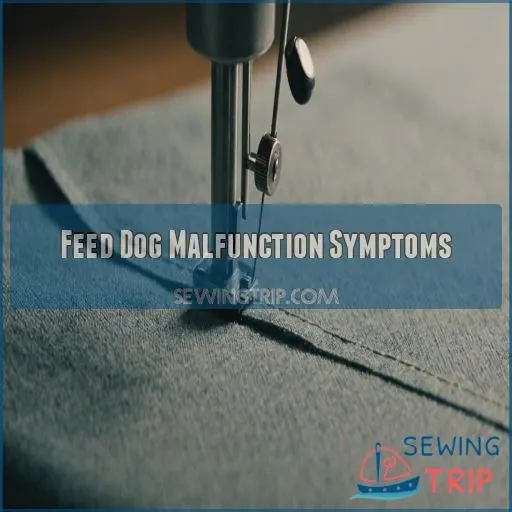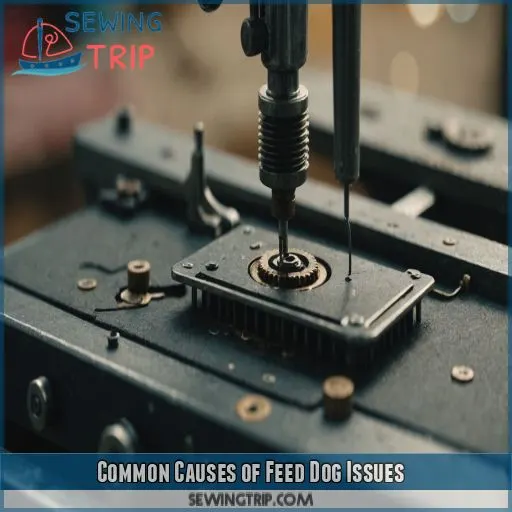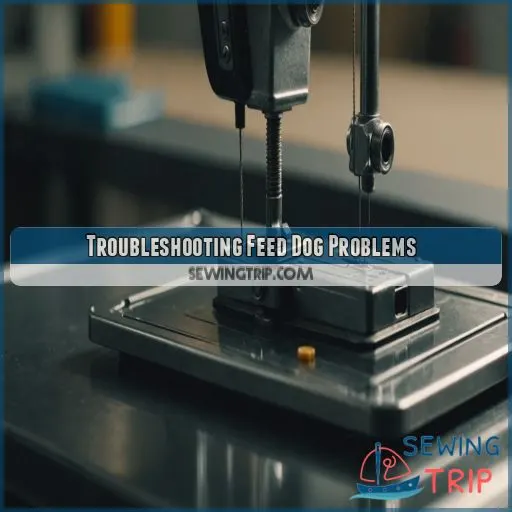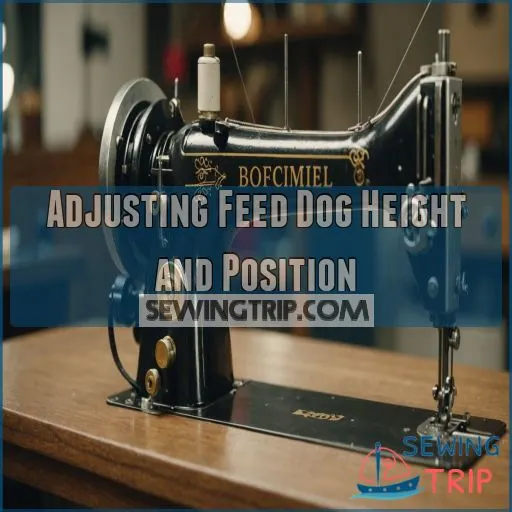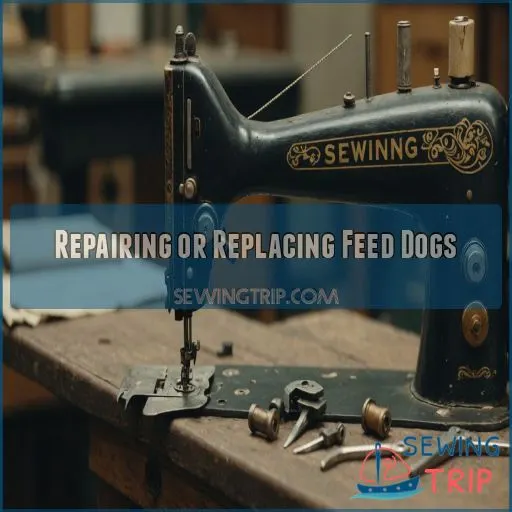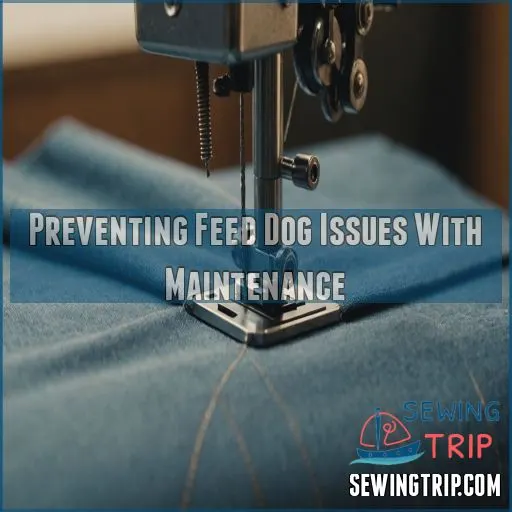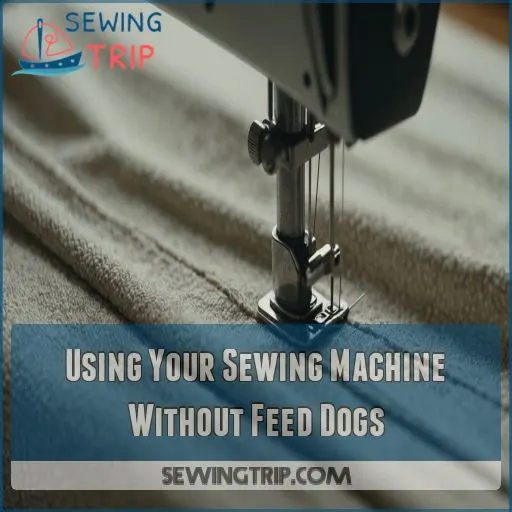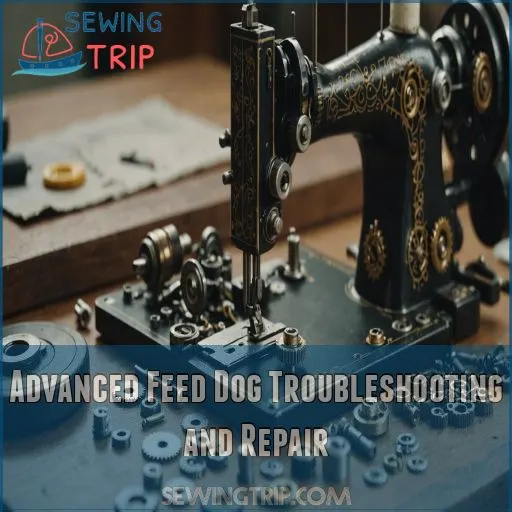This site is supported by our readers. We may earn a commission, at no cost to you, if you purchase through links.
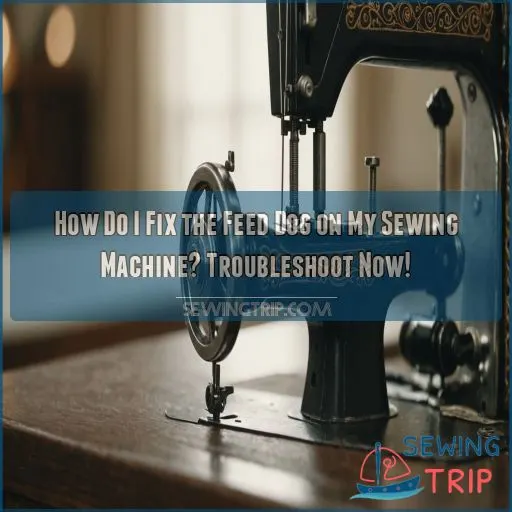 Fixing your sewing machine’s feed dog is a breeze once you know the common culprits. First, check if the feed dog lever is stuck in the down position – that’ll stop your fabric from moving.
Fixing your sewing machine’s feed dog is a breeze once you know the common culprits. First, check if the feed dog lever is stuck in the down position – that’ll stop your fabric from moving.
Next, make sure your stitch length and bobbin tension are dialed in correctly.
If your feed dogs are clogged with lint, a quick cleaning will get them back in action.
And if you spot any loose screws or broken parts, tighten ’em up or replace ’em. With a little troubleshooting, you’ll have your feed dogs gripping that fabric like a pro in no time. Stay tuned for more advanced tips to keep your machine purring!
Table Of Contents
- Key Takeaways
- Feed Dog Malfunction Symptoms
- Common Causes of Feed Dog Issues
- Troubleshooting Feed Dog Problems
- Adjusting Feed Dog Height and Position
- Repairing or Replacing Feed Dogs
- Preventing Feed Dog Issues With Maintenance
- Using Your Sewing Machine Without Feed Dogs
- Advanced Feed Dog Troubleshooting and Repair
- Frequently Asked Questions (FAQs)
- Conclusion
Key Takeaways
- Don’t panic when your sewing machine’s feed dogs act up — with a little troubleshooting, you can get those stubborn metal teeth back in action in no time by checking out this article! Start by checking the feed dog lever, adjusting stitch length and bobbin tension, and giving those dogs a good cleaning.
- Preventing feed dog issues is key — regular maintenance like lubrication and cleaning will keep your machine purring. Stay vigilant for signs of wear and tear, and don’t be afraid to consult your manual or a pro if things get tricky.
- You can still sew without feed dogs by trying free motion techniques or adjusting your settings. Get creative and embrace the challenge — with a little practice, you’ll be sewing like a pro, feed dogs or not.
- Tackling complex feed dog problems takes some sleuthing, but don’t be intimidated. Diagnose the issue, source replacement parts, and dive into advanced maintenance and adjustment tricks. Your sewing machine will thank you with flawless stitches every time.
Feed Dog Malfunction Symptoms
When your sewing machine’s fabric seems stuck or the feed dogs refuse to budge, it feels like the universe is conspiring against your DIY project.
Don’t panic; understanding symptoms like these can keep your sewing journey stitch-perfect.
Fabric Not Moving or Sticking
So, your fabric’s stuck, refusing to move? We’ve all been there. Here’s how you can tackle this sewing machine problem:
- Check tension issues: Adjust the upper and bobbin thread tension to reduce fabric slippage.
- Inspect needle problems: Make sure it’s sharp and not bent.
- Regular machine cleaning: A clean machine can prevent stuck feed dogs from misbehaving.
Your fabric’s back in action!
Feed Dogs Not Raising or Lowering
If your feed dogs aren’t raising or lowering as they should, check the feed dog lever first.
It may be stuck in the down position, preventing the dogs from doing their job.
If the lever is up, inspect the linkage for any loose screws or broken parts.
Consult your sewing machine manual for specific adjustment instructions.
Incorrect Timing or Synchronization
You’ve wrangled the feed dogs into place, but that rhythm’s still off! When feed dog timing goes haywire, your sewing machine’s harmony misses a beat.
Check the needle plate alignment first.
Tension synchronization might need a tweak too.
If it’s all Greek to you, maybe that drive belt or drive motor’s playing tricks.
Keep fabric thickness and stitch length in mind!
Feed Dogs Not Gripping Fabric Properly
Ever felt like your fabric’s doing the cha-cha while you’re sewing? Your feed dogs just might be slacking! Check presser foot pressure and make sure you have the correct stitch length.
Light fabrics? Add stabilizer. Reduce sewing speed for control.
Consider needle type – a sharp needle grips better. Regular sewing machine maintenance and these tips keep feed dogs gripping like a pro!
Common Causes of Feed Dog Issues
When your sewing project’s not smooth, the feed dogs might be barking up the wrong tree!
Common culprits include an improperly set lever, mismatched stitch length, or even feed dogs that are simply clogged with more lint than your dryer trap.
Feed Dog Lever in Down Position
The feed dog lever on your sewing machine may be in the down position, which disengages the feed dogs and allows for free motion sewing.
This is great for quilting and other specialized techniques, but it’ll prevent your fabric from moving properly during regular sewing.
Check that lever and raise it back up to get those feed dogs working again!
Incorrect Stitch Length or Bobbin Tension
Can’t get your fabric moving right? Check that stitch length and bobbin tension!
Imagine your sewing machine as a tiny rollercoaster; if the train’s track isn’t set right, it won’t work its magic.
Optimize stitch length and adjust tension for your fabric type and needle size.
It’s like giving your machine a spa day, ensuring smooth sewing adventures!
Dirty or Clogged Feed Dogs
If you’re wrestling with a stubborn sewing machine even after fixing stitch length, it might have dirty or clogged feed dogs. Dust bunnies love hiding there! Grab feed dog cleaning tools, tackle lint buildup, and prevent it from piling up.
Clean regularly using recommended cleaning solutions, and steer clear of common mistakes.
Keeping those teeth clean will have your machine running smooth as silk!
Fabric Too Smooth or Thin
When fabric is too smooth or thin, your sewing machine feed dogs might struggle. Here’s how to tackle that slippery problem:
- Increase Presser Foot Pressure: Give those feed dogs a better grip.
- Use a Walking Foot: Ideal for quilting fabric or sticky fabrics.
- Try Free Motion Quilting: Gain control without feed dogs.
- Layer with Tissue Paper: Enhance grip and prevent slippage.
Linkage Issues or Broken Parts
Chances are, if your feed dogs aren’t moving as they should, there may be some linkage issues or broken parts at play. Check for any loose screws or worn components that could be causing the problem. Replacing a damaged feed dog assembly is often the best solution, but you’ll want to tread carefully – DIY repairs can get tricky. Consider reaching out to a professional if you’re unsure.
| Issue | Potential Cause | Solution |
|---|---|---|
| Loose Screws | Linkage components coming undone | Tighten all screws on feed dog assembly |
| Worn Parts | Damaged or broken feed dog components | Replace entire feed dog unit |
| Complex Repairs | Intricate internal mechanisms | Seek professional sewing machine technician |
| Safety Concerns | Risk of further damage | Avoid DIY repairs beyond your skill level |
| Cost Savings | Professional service fees | Weigh repair costs vs. replacing machine |
Troubleshooting Feed Dog Problems
You’re frustrated with feed dogs that just won’t cooperate on your sewing machine, right?
Let’s get those stubborn metal teeth back in action with a few easy troubleshooting tricks that’ll have you back to stitching in no time!
Checking Feed Dog Lever Position
Before diving into stitches, take a peek at the feed dog’s lever position.
Why? A misplaced lever’s like a face mask on backward—useless!
Locate the lever, often tucked near the shuttle race area.
Stuck lever? Jiggle it gently, avoiding frustration-fueled wrestling.
Identifying the correct position makes sure smooth fabric movement.
Levers love a good nudge, so troubleshoot smartly!
Adjusting Stitch Length and Bobbin Tension
So, after ensuring the feed dog’s in the right spot, let’s tackle stitch length and bobbin tension.
Picture driving a car—too fast or slow, and you’ll skid or stall. Adjust stitch length and tension based on fabric type and needle size.
It’s like perfectly tuning a guitar—once right, your sewing will sing!
Don’t forget appropriate thread type too.
Cleaning Feed Dogs and Sewing Machine
Cleaning the feed dogs and your sewing machine is really important. Use a small brush to gently remove any lint or debris. Don’t forget to clean the shuttle race and other nooks and crannies.
Regular maintenance keeps your machine running smoothly.
Refer to your manual for the recommended cleaning schedule and lubrication points. A well-maintained machine will sew like a dream!
Experimenting With Wax Paper or Fabric Adjustments
Smooth fabrics might be causing trouble with your feed dogs.
Try sandwiching wax paper between the fabric and the machine. It can offer extra grip and help fabrics glide smoothly.
Here’s how to tackle it:
- Cut wax paper to size.
- Place it under your fabric.
- Adjust stitch length settings accordingly.
This tip can work wonders!
Inspecting for Loose Screws or Broken Parts
Great, you’ve tried wax paper; now let’s go Sherlock on those feed dogs.
Grab a trusty screwdriver and visually inspect for loose screws in the feed dog assembly.
Is something rattling like a maraca? Tighten those screws good and tight!
Broken parts hiding? Get them replaced.
A little detective work goes a long way in smooth sewing adventures!
Adjusting Feed Dog Height and Position
If your sewing project’s in a jam because fabric’s not moving, adjusting your sewing machine’s feed dog height could save the day.
Let’s make sure those trusty feed dogs are working their magic by getting them perfectly aligned and ready to grip like a pro.
Raising or Lowering Feed Dogs Manually
If the feed dogs on your sewing machine aren’t cooperating, don’t fret – you can easily raise or lower them manually.
Look for the button or switch on the back or side of your machine, and move it to the dropped position. This will lower the feed dogs for free motion sewing or thick fabrics.
To raise them back up, simply switch it to the raised position and turn the hand wheel to see them move. Easy peasy!
- Locate the feed dog lever or switch
- Move it to the dropped position to lower the feed dogs
- Switch it to the raised position to bring the feed dogs back up
- Turn the hand wheel to check that the feed dogs are moving properly
Adjusting Feed Dog Height for Specific Fabrics
For adjusting feed dog height for specific fabrics, you’ve got options.
For that silky smooth fabric demanding grace and composure or those denim dreams needing extra grip, use this quick guide.
| Fabric Type | Feed Dog Setting |
|---|---|
| Thin | Lower Height |
| Thick | Raise Height |
Ensuring Proper Feed Dog Alignment
You’ve tackled adjusting feed dog height; now, let’s chat about getting those feed dogs properly aligned! Ensuring precise feed dog alignment keeps your sewing on the straight and narrow.
Check for proper needle placement, fabric types, and adjust presser foot pressure.
Double-check tension adjustments; it’s like tuning a banjo—hit the sweet spot, and your fabric won’t skip a beat!
Preventing Feed Dog Damage or Breakage
Want to keep your sewing smooth sailing? Don’t let feed dogs bite the dust!
Regular feed dog lubrication and sewing machine cleaning are your new best friends.
Check needle type and fabric thickness to match your project.
Balance thread tension like a pro.
Treat your feed dogs well, and they’ll serve you loyally without dramas or dropouts.
Repairing or Replacing Feed Dogs
If your sewing machine’s feed dogs are malfunctioning, don’t worry – you can often fix the issue yourself.
From replacing the feed dog assembly to seeking professional help, this article will guide you through the troubleshooting process and get your machine back in top shape.
Replacing Feed Dog Assembly or Components
Replacing feed dog components doesn’t have to be rocket science.
Some feed dog assembly types are DIY-friendly, but make sure the parts are compatible.
Often, common failures need just a part swap.
Don’t forget, finding parts online is as easy as pie!
If you’re keen for control, with just a little elbow grease, you’ll have those feed dogs dancing again.
Consulting Sewing Machine Manual for Guidance
Diving into your sewing machine manual can feel like opening a treasure chest of know-how. Here’s a little map to guide you:
- Check diagrams for troubleshooting your feed dogs.
- Identify parts needing maintenance or repair.
- Learn proper alignment techniques and adjustments.
- Uncover hidden tips for keeping your machine in tip-top shape.
Make that manual your trusty sidekick!
Seeking Professional Assistance for Complex Issues
You’ve checked your sewing machine manual, but the problem persists.
It’s time for the big guns: consult a qualified technician!
Like a trusty mechanic for your car, sewing machine repair shops have the expertise to fix stubborn feed dog issues.
Consider warranty coverage and weigh DIY vs. professional repair costs.
Sometimes, letting the pros handle it saves you time and trouble!
Purchasing Replacement Parts From Reputable Retailers
If the feed dogs on your sewing machine need replacing, don’t fret – you’ve got this! Purchasing quality replacement parts from reputable online retailers or your local sewing shop is key. Look for parts that are compatible with your machine, check the warranty, and compare prices to get the best deal. This’ll have your feed dogs back in tip-top shape in no time!
- Prioritize parts compatibility with your sewing machine model.
- Look for warranties and return policies in case the part doesn’t fit.
- Compare prices between online and local retailers to find the best value.
Preventing Feed Dog Issues With Maintenance
You don’t want your sewing project to stall because of a stubborn feed dog, so let’s keep your machine running smoothly with some easy maintenance tips.
Give those little metal teeth a spa day with regular cleaning and lubrication; it’ll keep them chomping along for years to come!
Regularly Cleaning Sewing Machine and Feed Dogs
You know what they say, "A stitch in time saves nine!" Regular cleaning keeps your sewing machine’s feed dogs barking happily. Use the right tools like brushes to remove lint. Clean often to avoid drama later.
Here’s a quick guide:
| Task | Tools Used | Frequency |
|---|---|---|
| Lint Removal | Brush | After projects |
| Maintenance Check | Manual | Monthly |
| Deep Clean | Vacuum | Bi-Annually |
A tidy machine is a happy machine!
Lubricating Moving Parts and Feed Dogs
So, you’ve cleaned your sewing machine, but don’t forget to lubricate those moving parts and feed dogs! Think of it like giving your sewing machine a spa day—use sewing machine oil, not just any old lubricant.
Grab your lubrication tools, follow your maintenance schedule, and keep things moving smoothly.
Regular lubrication frequency can save you heaps of trouble later. Happy sewing!
Inspecting for Wear and Tear or Damage
Keeping an eagle eye out for any telltale signs of wear and tear or damage on your feed dogs is key.
Look for bent, cracked, or missing teeth – these could hamper your fabric’s smooth sailing.
And don’t forget to inspect the needle plate for any nicks or grooves that might snag your material.
Staying vigilant will keep your sewing machine shipshape.
Scheduling Regular Sewing Machine Maintenance
Inspecting your sewing machine regularly is like giving your car a tune-up. Just like it keeps your wheels rolling, a good maintenance schedule extends your sewing machine’s lifespan. Consider:
- Setting reminders for routine checks
- Performing preventative measures yourself
- Knowing DIY versus professional scenarios
- Weighing cost-benefit analysis for professional services
- Avoiding heartache from sudden breakdowns by staying proactive
Using Your Sewing Machine Without Feed Dogs
Think your feed dogs are dog-tired? You can still sew by trying free motion techniques or adjusting stitch length and tension to maintain creativity without them!
Free Motion Sewing Techniques
In free motion quilting, the feed dogs are dropped—unleashing your creative potential!
Imagine your sewing machine as a wild horse; you’ve got the reins.
Stabilizing fabric is key, so don’t skip that! Adjust thread tension and practice until you’re in the groove.
Choose a machine that feels like an old friend, ready to join your sewing adventures.
Using Alternative Feed Mechanisms or Attachments
If your sewing machine lacks feed dogs, consider using a walking foot or seam ripper to guide the fabric.
A stitch regulator can also help with free motion sewing, allowing you to control the stitches without relying on feed dogs.
Fabric guides are another handy attachment for keeping your material moving smoothly.
Adjusting Stitch Length and Tension for Feed Dog-Free Sewing
Defying convention with free-motion quilting enables creativity, but it’s important to tweak settings for success.
Adjust your stitch length and tension for feed dog-free sewing.
Keys to success include:
- Stitch Length Impact: Longer stitches means less friction.
- Tension Control: Avoid bunching by balancing bobbin tension.
- Fabric Type: Thicker fabrics might need extra tweaks.
Get it right, and you’ll be sewing smooth as butter.
Considering Feed Dog Replacement or Repair
When feed dogs grind your gears, consider a cost-benefit analysis: DIY or pro repairs?
Check warranty options for coverage or explore alternative solutions like feed dog-free sewing.
Common mistakes include ignoring worn parts, leading to bigger headaches.
Advanced Feed Dog Troubleshooting and Repair
Tackling complex feed dog problems can feel like chasing a squirrel up a tree, but with a few tricks, you’ll have your machine humming again.
You’ll explore how to repair or replace those pesky internal components, ensuring your sewing projects don’t hit a snag.
Diagnosing Complex Feed Dog Issues
Pinpointing complex feed dog issues takes some sleuthing.
Start by inspecting the feed dog linkage for any loose screws or worn parts.
If the timing seems off, the internal gears may need adjustment.
Don’t be afraid to get your hands dirty – with patience and the right know-how, you can get those feed dogs working like new.
Repairing or Replacing Internal Feed Dog Components
Identifying broken parts sounds intimidating, but it’s just like finding a sock’s hole—tricky but doable.
When sourcing replacements, trust reputable shops.
Disassembly tips? Imagine unscrewing puzzle pieces. Follow reassembly instructions like assembling IKEA furniture (minus the frustration).
Common component failures can stump, but a bit of patience and a good manual can transform you into a sewing machine whisperer.
Advanced Feed Dog Maintenance and Adjustment Techniques
Now that you’ve tackled replacing broken parts, let’s jazz up those feed dogs with advanced maintenance and alignment tricks.
Just like a smooth tango, proper feed dog alignment and lubrication techniques can keep your sewing machine dancing.
Tweak those timing adjustments and explore replacement options, ensuring everything’s in sync.
Your machine will thank you with a flawless stitch every time!
Frequently Asked Questions (FAQs)
Why is my sewing machine feed dogs not working?
If your feed dogs are on strike, it might be due to being set too low, dirty, or needing a stitch-length adjustment.
Check they’re up, clean and aligned;
sometimes, they just need a little TLC.
How to adjust sewing machine feed dogs?
To adjust your sewing machine’s feed dogs, locate the switch or lever—it’s usually near the presser foot.
Shift it to raise or lower the dogs.
Clean them regularly to prevent fabric jams.
Consult your manual for details.
Could you still use your sewing machine if your feed dogs were not functioning?
You can still use your sewing machine if the feed dogs aren’t working, but it’ll be a real pain.
Without those little teeth moving the fabric, you’ll have to guide it through manually – not fun! (Source)
Why won’t my feed dogs raise?
Isn’t it amusing how things work perfectly until they don’t?
Check if your feed dog lever is in the up position.
Clean any lint clogging them, and raise them using the handwheel, ensuring linkages are intact.
What tools are needed for feed dog repair?
Feeling brave enough to tackle your feed dog repair?
You’ll need a screwdriver, tweezers, small brush, and sewing machine oil.
Keep your wits sharp and remember, even the Thread Whisperer started somewhere!
Happy fixing!
Are specific feed dogs needed for heavy fabrics?
Funny enough, feed dogs got their name for a reason.
They’re like fabric wranglers.
Make sure they grip well by adjusting height or tension if your fabric’s thick.
No unique feed dogs needed, just some TLC and adjustments!
How often should I clean feed dogs?
You should clean your feed dogs regularly, say every few projects or when you notice a buildup of lint.
It’s a quick task that’ll keep your machine humming along smoothly.
Just use a soft brush to gently sweep away any debris.
Can I sew without adjusting feed dog height?
Sewing with unadjusted feed dog height is like driving on a road with speed bumps—it’ll still work, but not smoothly.
For the best control, make sure your feed dogs are set correctly to grip fabric and avoid frustrations.
How to improve feed dog grip on fabric?
Struggling to teeter-totter your fabric with feed dogs?
Consider upping the pressure on the presser foot, adjust those stitch lengths, or try a different needle.
A quick clean-up might just do the trick as well.
Conclusion
Think of fixing the feed dog on your sewing machine like unraveling a tangled thread—possible with patience and the right approach to fabric feeding issues.
By mastering the signs of malfunction and employing the troubleshooting techniques you’ve learned, you’ll handle feed dog challenges with ease.
Continue your sewing adventures with regular maintenance and stay attuned to your machine’s needs.
Explore new possibilities, knowing you’re now equipped to keep your sewing machine running smoothly and creatively.

